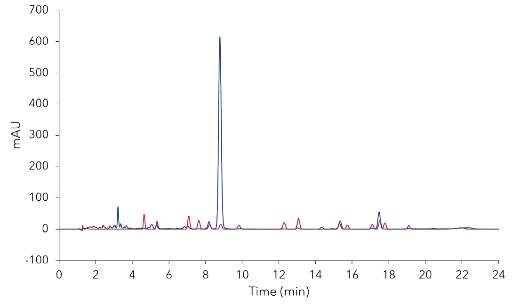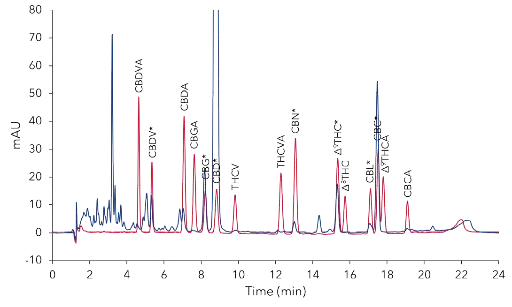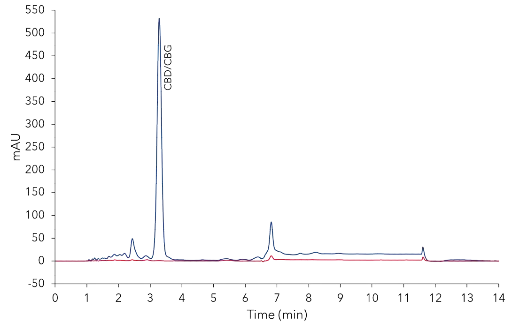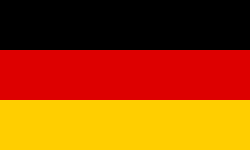
Science with Passion
Application No.: VPH0074 Version 1 08/2020
Purification of cannabidiol from CBD oil by preparative HPLC
Yannick Krauke, Kate Monks; applications@knauer.net
KNAUER Wissenschaftliche Geräte GmbH, Hegauer Weg 38, 14163 Berlin

Summary
The demand of pure cannabidiol (CBD) is increasing and therefore methods are needed that allow purification of CBD in high purity from different kind of samples i.e. cannabis extract, paste or oil. Preparative HPLC is a well-established method for purification of target substances from natural substrates in high purities and was therefore applied for this task. In this application a preparative HPLC method was developed for purification of CBD from a commercial CBD rich oil. CBD was purified with high purity and recovery thus increasing the purity from 71.6% to 94.5%.
Introduction
Cannabis sativa is used in agricultural and medical applications already for a long time. It contains a variety of compounds such as terpenoids, flavonoids and cannabinoids among which tetrahydrocannabinol (Δ9-THC) and cannabidiol (CBD) are the most abundant [1]. Δ9-THC is known for its psychoactive effects and is applied as medical treatment, but underlies strict legal regulations in most countries. CBD does not have the intoxicating effects of THC, and therefore the legislations are much more relaxed, yet. Depending on the field of application there are cannabis breeds with high THC content and others with low THC but high CBD content. As CBD shows medicinal effects as THC and is used i.e. for the treatment of neuropathic pain and chronic inflammatory conditions, the demand is growing. Many products such as CBD oil, drops and cosmetics are also available on the market [2,3,4,5]. The demand of highly pure CBD and other cannabinoids is increasing, and therefore different purification strategies are developed. Here, the purification of CBD from a CBD oil is described using a KNAUER AZURA® preparative HPLC system. An already described methanol–based gradient purification method was optimized for the purification of solely CBD7. Further, the whole process from sample analysis over method development in analytical scale, the scale-up to preparative scale and finally the purification of CBD is shown. Due to strict regulatory conditions concerning the novel food legislation in 2019 , it was difficult to acquire a CBD rich paste or other CBD process sample. For this reason, a commercial CBD rich oil was used as sample.
Results
The CBD-Loges® oil was analyzed with the previously described acetonitrile method6. The chromatogram of the CBD oil showed one large peak at tR 8.9 min and several significant smaller peaks (Fig. 1 and Fig. 2). Most impurities eluted within the first 5 minutes (Fig. 2). An overlay with the chromatogram of a standard mixture of 16 cannabinoids and subsequent retention time comparison led to the identification of seven cannabinoids: CBDV, CBG, CBD, CBN, Δ9THC, CBL and CBC (Fig. 2). A larger, early eluting peak group eluted within the first 5 minutes, and two larger unidentified peaks at approximately 5 and 14.4 minutes (Fig. 2).

Fig. 1 Overlay chromatograms of CBD oil sample (blue) and mixture of 16 cannabinoids (red). CBD oil sample 5 mg/ml; standard concentration
5 µg/ml each; 10 µl injection, 228 nm; C18P, 3 µm, 150 x 4.6 mm ID.

Fig. 2 Detailed view of Fig. 1 with the 16 cannabinoids standard mixture. Positive identified substance peaks are highlighted with * in sample.
A five-point calibration curve for CBD and CBG was measured and the resulting coefficients were above R>0.999 for both cannabinoids (Fig. 3). The calibration was used for the analysis of the CBD oil sample.

Fig. 3 Calibration curves and linearity for the cannabinoids CBG and CBD for analytical ACN method at 228 nm.
The results show that CBD is the most abundant cannabinoid in the sample with approximately 72% (area), while the CBG content is 2.6%. The remaining 25.8% (area) were accounted for other cannabinoids, impurities, and unidentified peaks (Tab. 1). The calculated CBD percentages in 1 mg CBD oil were 5.29% CBD which is close to the manufacture indications of 5.35% CBD.
Tab. 1 Analysis composition of identified cannabinoids in CBD oil sample (5 mg/ml). Integration interval 1.5 min – 20 min; global width 0.1 min; global threshold 0.1 mAU.
Area % | Concentration ug/ml | % in 1 mg CBD oil | |
CBG | 2.60 | 12.07 | 0.24 |
CBD | 71.60 | 264.55 | 5.29 |
others | 25.80 |
Next, a purification method was developed to purify CBD with higher purity. In contrast to a previous developed method where several cannabinoids were purified7, here CBD was the only target substance. A methanol-based two–step gradient method was developed in analytical scale on a C18 column with 10 µm particle size (Fig. 4; Tab. 6). Comparison of the chromatograms of the CBD oil sample, CBD and CBG standard chromatograms revealed nearly coelution of both substances in the main peak tR 3.3 min (Fig. 4).

Fig. 4 CBD-Loges oil sample (5 mg/ml) with two-step gradient methanol method at 228 nm (blue) and 306 nm (red); C18, 3 µm, 150 x 4.6 mm ID.
The maximum solubility of the oil in methanol/water (75%/25%, v/v) was 50 mg/ml. Larger quantities were not soluble (data not shown). A volume overload study injecting different sample volumes with a 50 mg/ml CBD oil sample was performed. The results showed that also with 20 µl injections the CBD peak had nearly linear absorption behaviour (Fig. 5).

Fig. 5 Volume overload study. 2 µl (blue), 5 µl (red), 10 µl (grey) and 20 µl (green) injection of 50 mg/ml CBD-Loges oil sample; C18, 10 µm, 150 x 4.6 mm ID.
A linear up-scaling of the method was performed to increase the yield. The column ID was increased from 4.6 mm to 50 mm and the flow rate from 1.2 ml/min to 140 ml/min (Tab. 7). Parameters were calculated with the KNAUER ScaleUp Converter. By enlarging the column diameter, the injection volume was increased. The sample was injected with one channel of the major pump using the ternary LPG module thus reducing the need of an injection valve and therefore simplifying the preparative HPLC system. Pre–mixed solvents were used. The sample injection was performed with a lower flow rate then the main flow to guaranty a more precise sample injection (Tab. 7). As the sample amount and solvent consumption were high, no test runs were performed and the target peak manually collected immediately during the first run of a 15 ml sample injection (Fig. 6).

Fig. 6 Preparative purification of CBD. 15 ml sample with 50 mg/ml injection and fractionation of CBD peak. C18, 10 µm, 150 x 50 mm ID.
The PurityChrom software allows these direct interactions during the run. The collected fraction was analyzed, and the chromatogram compared to the chromatogram of the injected CBD oil sample. The results clearly showed that only CBD, CBG and a small amount of impurities were detected, but none of the early or late eluting compounds (Fig. 7).

Fig. 7 Analysis of the CBD fraction from Fig. 5 and overlay with CBD oil sample chromatogram. 10 µl injection, analytical ACN method.
The area percentages (indicator for purity) of CBD and CBG, and the percentage of the total amount were determined for the collected fraction (Tab. 2).
Tab. 2 Analysis of fractions from preparative purification (15 ml injection with 50 mg/ml) of cannabinoids from CBD oil sample. For each fraction area % of identified cannabinoids and % from total sample are shown. Integration interval 1.5 min – 20 min; global width 0.1 min; global threshold 0.1 mAU.
Sample | Fraction 1 | |||
Area % | Approx. mg in 15 ml sample | Area % | Approx. mg in fraction | |
CBG | 2.60 | 1.80 | 3.10 | 1.30 |
CBD | 71.60 | 39.7 | 94.50 | 42.50 |
others | 25.80 | 2.40 |
The purity of CBD was increased from approximately 71.6% in the CBD oil to 94.5% in the collected fraction. The total amount of CBG in the 15 ml injected sample (750 mg CBD oil) was approximately 40 mg. For the collected fraction, the CBG content was approximately 42.5 mg. The difference between the two values can be due to small errors caused by factors such as dilution steps. It can be assumed that the CBG was completely recovered by the fractionation.
Tab. 3 Sample and CBD throughput per day with tested parameters
Method | ||
Column dimension | 150x50 mm | |
Flow rate | 140 ml/min | |
Run time | 12 min | |
Sample conc. (CBD oil) | 50 mg/ml | |
Injection volume | 15 ml | |
Sample amount | 750 mg | |
CBD content | 5.3% | |
CBD purity | 71.6% | |
CBD amount | 40 mg | |
Results purification | ||
CBD purity | 94% | |
CBD recovery | 100% | |
CBD yield | 40 mg | |
Throughput | Load (750 mg/run) | CBD (40 mg/run) |
5 runs (12 min)/hour | 3.75 g/h | 0.2 g/h |
8h/day | 30 g/d | 1.6 g/d |
Sample Preparations
A commercially available CBD rich oil was used for this application (CBD-Loges oil, 10 ml, with hemp extract containing 5.35% CBD). This oil contained also a high amount of sesame oil. The oil was diluted in methanol to indicated concentration (i.e. 5 mg/ml) and sonicated for 15 minutes. After 10 minutes of settling the solution was filtered through 0.2 µm PTFE syringe filter to remove the unpolar part of the mixture. For higher oil concentrations (50 mg/ml) filtration and settling were repeated. Cannabinoid calibration standards were prepared from 1 mg/ml cannabinoid standard solution (Tab. 4) and diluted with methanol to indicated concentrations. A five-point calibration curve with 0.4 µg/ml, 2 µg/ml, 10 µg/ml, 50 µg/ml, 100 µg/ml of each of CBD and CBG was established.
Conclusion
The analysis of the CBD-Loges oil showed that the main cannabinoid was CBD with 71.6% purity. The manufacturer’s information that the oil contains 5.35% CBD was confirmed with results from analysis that calculated 5.29% CBD in the sample. A preparative two-step gradient method based on methanol was developed to purify CBD in high purity and yield from the CBD oil. From a 15 ml sample injection (750 mg CBD oil) approximately 40 mg CBD with 94.5% purity were purified. The low yield of the described process is due to the low concentration of CBD in the sample. The total sample throughput is higher then the yield (Tab. 3). These results clearly highlight that the yield of a process is not only depended on the throughput but also from the target concentration in the sample and of the solubility in the solvent. Increasing the target concentration in the sample and finding a better solvent would significantly increase the yield and productivity. The results proved the simplicity of a linear scale-up and the advantages to perform method optimization in analytical scale. This approach saves time, sample and solvent. It also shows how a simple preparative AZURA HPLC system with a pump, a single wavelength detector and a fractionation valve is used to purify highly pure target substances from a sample. Fractionation was performed manually to avoid test runs and thus spare sample and solvent. This method could be changed to other solvents such as ethanol, acetonitrile, or even normal phase but then the method development must be started from the beginning.
KNAUER does not endorse the use of its products in connection with the illegal use, cultivation or trade of cannabis products. KNAUER does not endorse the illicit use of marijuana, we merely provide an overview of the methods and systems of cannabis analysis and purification.
Materials and Methods
Tab. 4 Standard solutions and samples
Analyte | CAS | Purity / Concentration |
Cannabidiol (CBD) | 13956-29-1 | 1.000 mg/ml (MeOH) |
Cannabigerol (CBG) | 25654-31-3 | 0.995 mg/ml (MeOH) |
Solvent | CAS | Purity / Concentration |
Acetonitril | 75-05-8 | Gradient grade |
H3PO4 | 7664-38-2 | AnalaR 85% NORMAPUR |
Methanol | 67-56-1 | Gradient grade |
Sample | Manufacturer | Batch |
CBD–Loges oil (Cannabis oil) | Dr. Loges | MA-19160911-2 |
Tab. 5 Analytical acetonitril (ACN) method
Column temperature | 25 °C |
Injection volume | 10 µl |
Injection mode | Partial loop |
Detection | UV 225 nm/306 nm |
Data rate | 10 Hz |
Gradient | |||
Eluent (A) | Water, HPLC grade pH 2.2 (H3PO4 85%) | ||
Eluent (B) | Acetonitrile, gradient grade | ||
Flow rate | 1.0 ml/min | ||
Time (min) | A (%) | B (%) | |
Pump program | 0 | 25 | 75 |
7 | 25 | 75 | |
17 | 10 | 90 | |
19 | 10 | 90 | |
20 | 25 | 75 | |
25 | 25 | 75 |
Tab. 6 Analytical methanol method
Column temperature | 25 °C | ||
Injection volume | 10 µl | ||
Injection mode | Partial loop | ||
Detection | UV 228 nm/ | ||
Data rate | 10 Hz | ||
Gradient | |||
Eluent (A) | Water | ||
Eluent (B) | Methanol, Gradient grade | ||
Flow rate | 1.2 ml/min | ||
Time (min) | A (%) | B (%) | |
Pump program | 0 | 10 | 90 |
5 | 10 | 90 | |
5.02 | 0 | 100 | |
10 | 0 | 100 | |
10.02 | 10 | 90 | |
15 | 10 | 90 |
Tab. 7 Preparative methanol method
Column temperature | RT | ||||
Injection volume | 15 ml | ||||
Injection mode | Main pump | ||||
Detection | UV 228 nm/ | ||||
Data rate | 2 Hz | ||||
Gradient | |||||
Eluent (A) | 90% methanol/10% water (v/v) | ||||
Eluent (B) | 100% methanol, gradient grade | ||||
Eluent (C) | Sample | ||||
Time (min) | A (%) | B (%) | C (%) | Flow rate (ml/min) | |
Pump program | 0.00 | 0 | 0 | 100 | 30 |
0.50 | 0 | 0 | 100 | 30 | |
0.56 | 100 | 0 | 0 | 140 | |
4.50 | 100 | 0 | 0 | 140 | |
4.56 | 0 | 100 | 0 | 140 | |
8.80 | 0 | 100 | 0 | 140 | |
8.86 | 100 | 0 | 0 | 140 | |
12 | 100 | 0 | 0 | 140 |
Materials and Methods
Tab. 8 Analytical system configuration
Instrument | Description | Article No. |
Pump | AZURA P 6.1L LPG | |
Autosampler | AZURA AS 6.1L, 700 bar | |
Detector | AZURA DAD2.1L | |
Puls Damper | High volume, stainless steel | |
Flow cell | Light guide 10mm/10 µl/300 bar | |
Thermostat | AZURA CT2.1 | |
Column | Eurospher II 100-3 C18P, 150 x 4.6 mm ID | |
Column | Eurospher II 100-10 C18, 150 x 4.6 mm ID | |
Software | ClarityChrom 8.1 – Workstation, autosampler control included | |
Software | ClarityChrom 8.1 – |
Tab. 9 Preparative system configuration
Instrument | Description | Article No. |
Pump | AZUAR P2.1L, | |
Ternary LGP module | AZURA LPG ternary module for pump P 2.1L | |
Assistant | AZURA ASM 2.2L Left: - Middle: UVD 2.1S Right: V 4.1 + 8Mpos, 1/8”, sst, 200 bar | AY00163 -------- |
Flow cell | 3 µl; 1/16” | |
Column | Eurospher II 100-10 C18, Column 150x50 mm | |
Software | PurityChrom®Basic |
References
[1] Bonini, S. A. et al. Cannabis sativa: A comprehensive ethnopharmacological review of a medicinal plant with a long history. Journal of Ethnopharmacology 227:300-315 (2018).
[2] Amin, M. R., Ali, D. W. Pharmacology of Medical Cannabis. Advances in Experimental Medicin and Biology 1162:151-165 (2019).
[3] ElSohly, M. A. et al. Phytochemistry of Cannabis sativa L. Progress in the Chemistry of Organic Natural Products 103:1-36 (2017).
[4] Lafaye, G., Karila, L., Blecha, L., Benyamina, A. Cannabis, cannabinoids, and health. Dialogues in Clinical Neuroscience 19(3): 309–316 (2017).
[5] Pisanti, S. et al. Cannabidiol: State of the art and new challenges for therapeutic applications. Pharmacology & Therapeutics 175:133-150 (2017).
[6] Loxterkamp, L., Monks, K. (C)an(n)alyze: determination of 16 cannabinoids inside flowers, oils and seeds. KNAUER Wisschenschaftliche Geräte GmbH (2020).
[7] Krauke, Y., Monks, K. Purify CBD and other cannabinoids by preparative HPLC. KNAUER Wissenschaftliche Geräte GmbH (2020).
Related KNAUER Applications
VPH0070 – (C)an(n)alyze: determination of 16 cannabinoids inside flowers, oils and seeds
VPH0072 – Analyzing cannabis flowers according to the German Pharmacopeia - monograph 2018
VPH0073 – Purify CBD and other cannabinoids by preparative HPLC
Application details
Method | HPLC |
Mode | RP |
Substances | Cannabinoids |
CAS number | 24274-48-4, 2808-33-5, 13956-29-1, 521-35-7, 1972-08-3, 21366-63-2, 20675-51-8 |
Version | Application No.: VPH0074 Version 1 | 08/2020 | ©KNAUER Wissenschaftliche Geräte GmbH |



